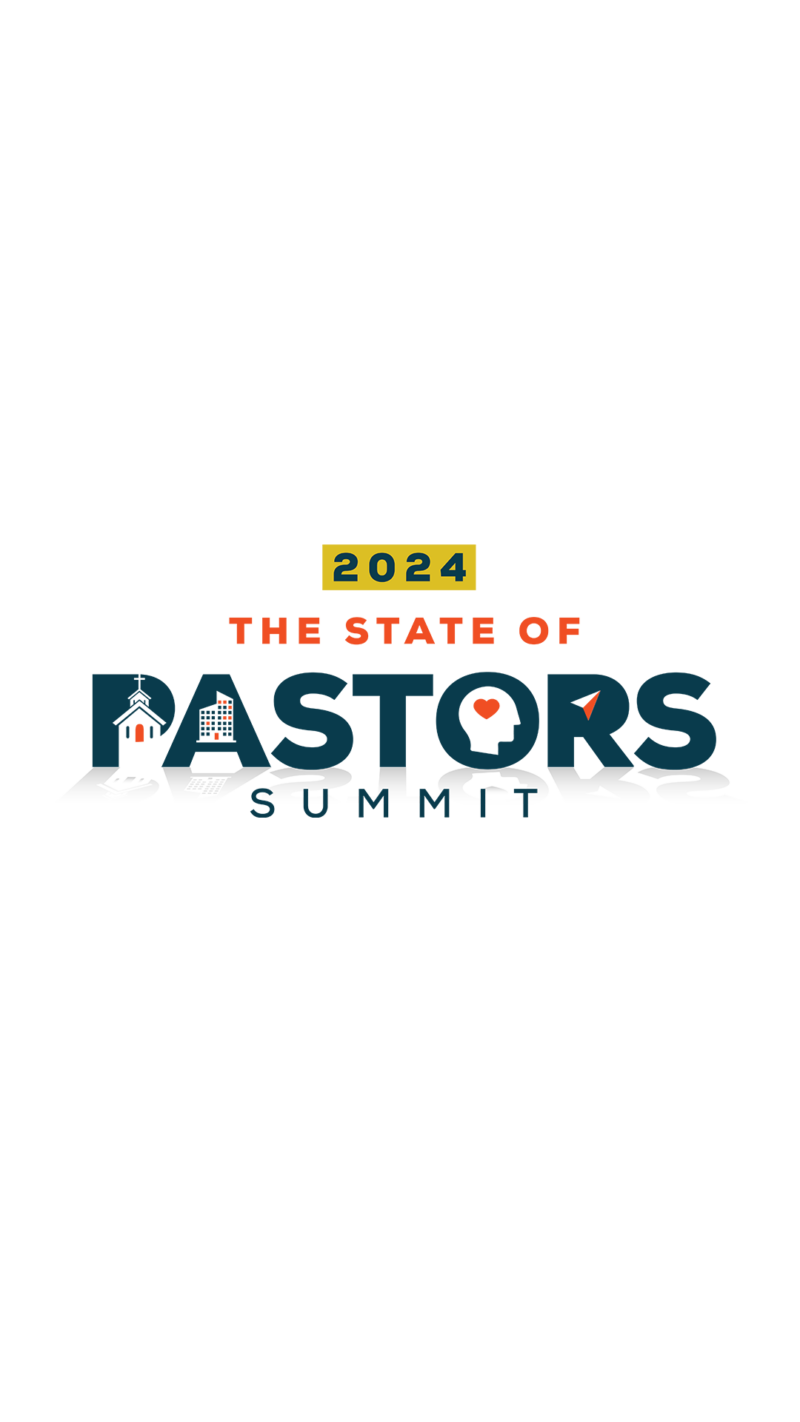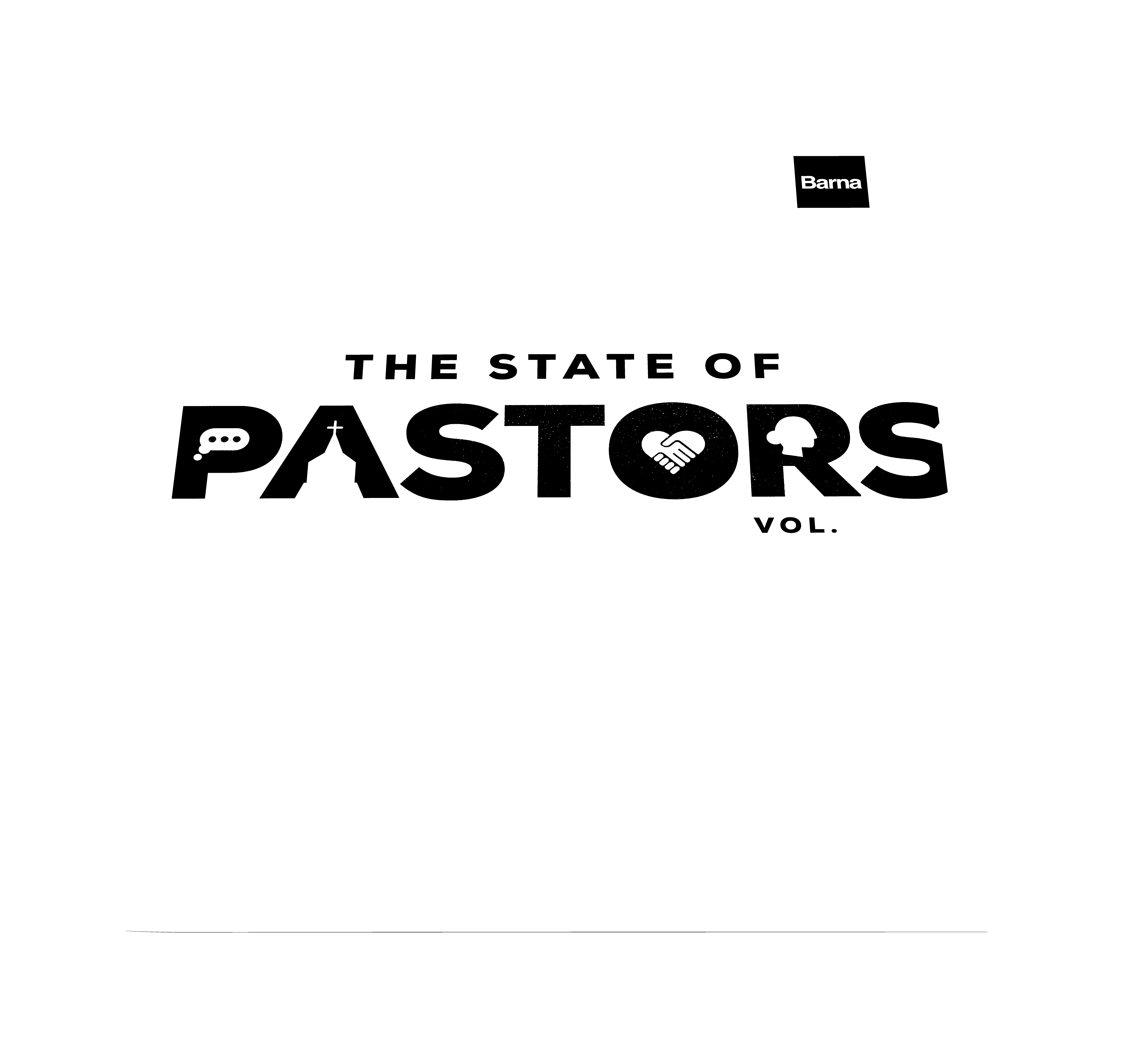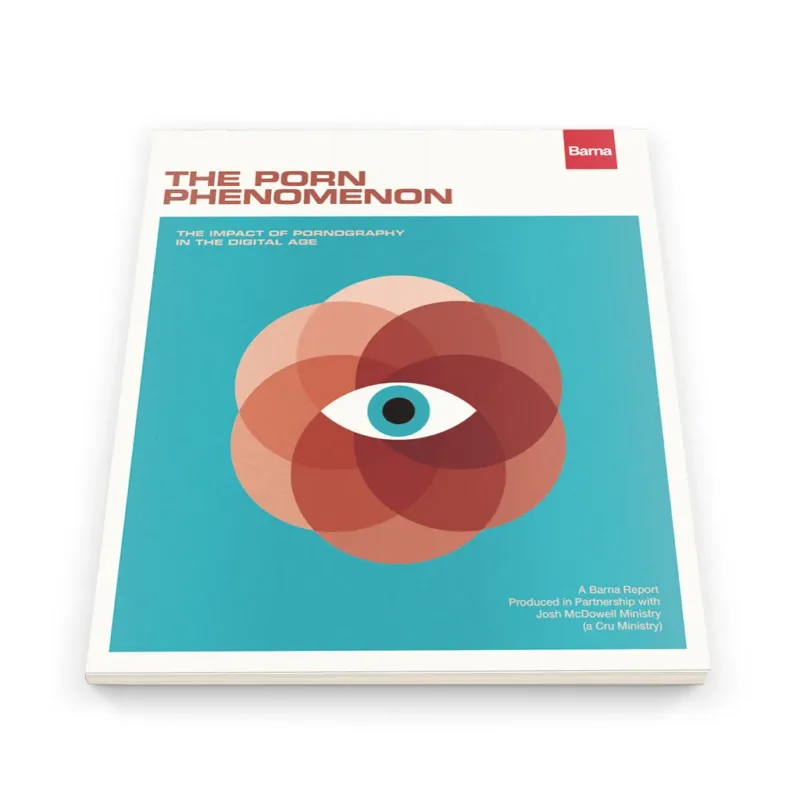Porn in the Digital Age: New Research Reveals 10 Trends

Pornography is not new, but the digital age has made it more ubiquitous and accessible than ever before. The technological realities of smartphones and high-speed internet have fundamentally changed the landscape of pornography, and ushered it into the cultural mainstream where it enjoys increasingly widespread acceptance.
In Barna’s landmark study, The Porn Phenomenon (now available to purchase online), commissioned by Josh McDowell Ministry, we interviewed thousands of American teens, young adults and older adults about their views on and use of pornography. Below, we’ll explore 10 of the most compelling findings.
1. There is Moral Ambiguity Toward Porn, Particularly Among Younger Americans
Perhaps the most sobering finding from the study is the reality of how accepted viewing porn has become in our culture today, particularly among teens and young adults. Around half of adults 25 and older say viewing porn is wrong (54%), and among teens and young adults 13-24, only a third say viewing porn is wrong (32%). This posture toward porn among younger Americans is confirmed by how they talk about porn with their friends: the vast majority reports that conversations with their friends about porn are neutral, accepting or even encouraging. They generally assume most people look at porn at least on occasion, and the morality of porn is rarely discussed or even considered. Just one in 10 teens and one in 20 young adults report talking with their friends about porn in a disapproving way.
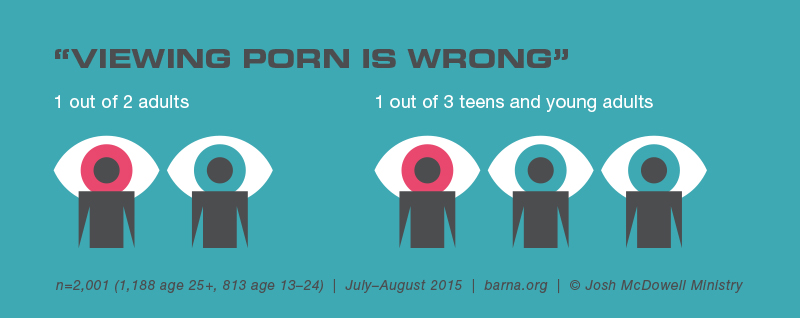
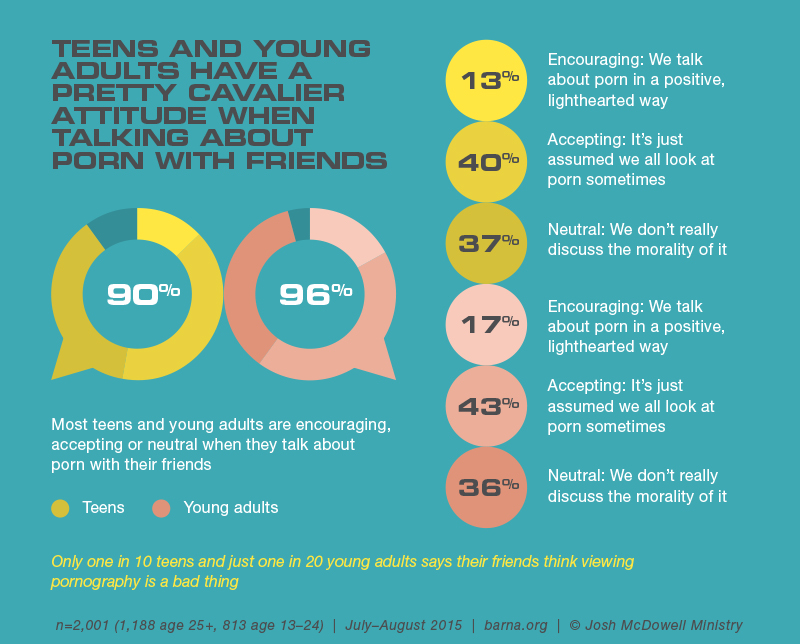
2. There are Varied Opinions About What Constitutes Porn
“I know it when I see it,” said Supreme Court Justice Potter Stewart famously when he was asked to define pornography. His statement demonstrates a perennial problem: It is notoriously difficult to define pornography. What counts as sexually explicit material is both highly subjective and highly contested, and this was true of Barna’s study. When teens, young adults, and adults are asked an open-ended question about what makes something “cross the line” into porn, the responses are varied, and cover both form (content) and function (intention for use). The top four indicators are all within a two percent range, with the most popular being something sexually explicit (17%). Just as common is when something displays a sexual act (16%), or sexual intercourse (16%), followed closely by whether something intends to arouse the viewer (15%) or contains full nudity (11%).
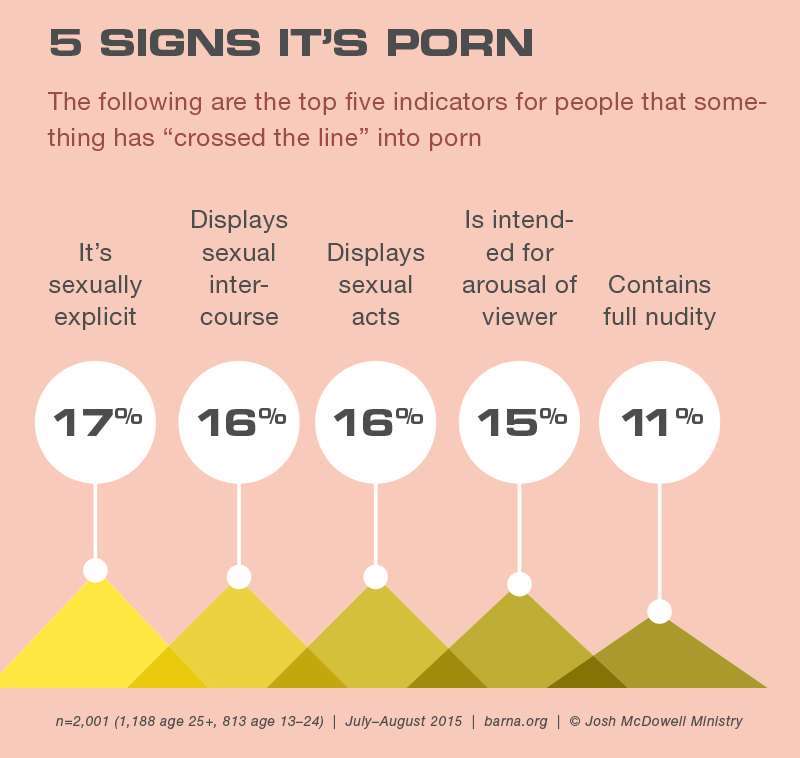
3. 1 in 3 Americans Seek out Porn at Least Once a Month
Measuring porn usage can be difficult, because living in a hyper-sexualized and pornified media culture means catching sight of explicit images with little or no effort. People often come across images they never intended to see through multiple inputs. That’s why it was important to distinguish between those who “view” porn, and those who “seek it out.” In other words, intention matters a lot. When we look at it this way, focusing exclusively on intentional viewing, we find that between 6 and 12 percent of people aged 13 and older view porn daily; 14 to 21 percent view porn weekly; 13 to 19 percent view it once or twice a month; and 18 to 32 percent view it less often. Half (49%) say they never seek out porn, and 17 percent say they have never come across it.
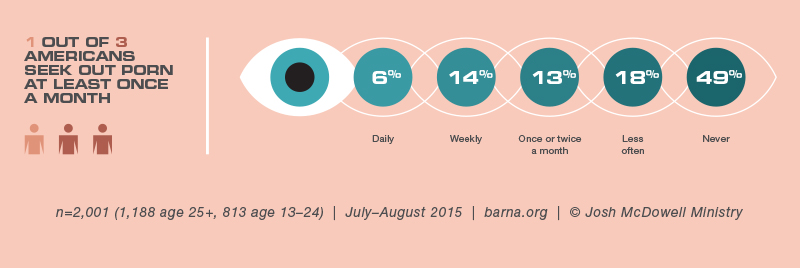
4. Age, Gender and Faith Practice are the Three Biggest Factors in Frequent Porn Use
When looking closely at frequent porn users (those who seek out porn daily, weekly and monthly), we begin to see patterns emerge according to age, gender and faith practice. To begin with, men use porn more frequently than women by a wide margin. Twice as many male teens and young adults use porn than female teens and young adults (67% compared to 33%), and four times as many male adults 25+ use porn than female adults (47% compared to 12%). Practicing Christians are more than three times less likely to use porn than other teens and adults (13% compared to 42%), and young adults (57%) are much more likely than both teens (37%) or adults 25+ (29%) to be a frequent porn user.

5. Young Adults Use More Porn—and are Less Likely to Say It’s Bad for Society
Among each of the generational groups, young adults 18-24 are the most frequent porn users. Almost six in 10 young adults (57%) seek out porn either daily, weekly or monthly. This is compared to a little over one-third of teens (37%), and almost 3 in 10 adults 25+ (29%). They are also the least likely to say that porn is very bad for society (14%). The next closest are Gen-Xers at 24 percent, but the largest gap is a 23 percent differential between young adults and Boomers (37% compared to 14%). Like teens (16%), young adults (17%) are also the least likely to say porn is “somewhat bad” for society.
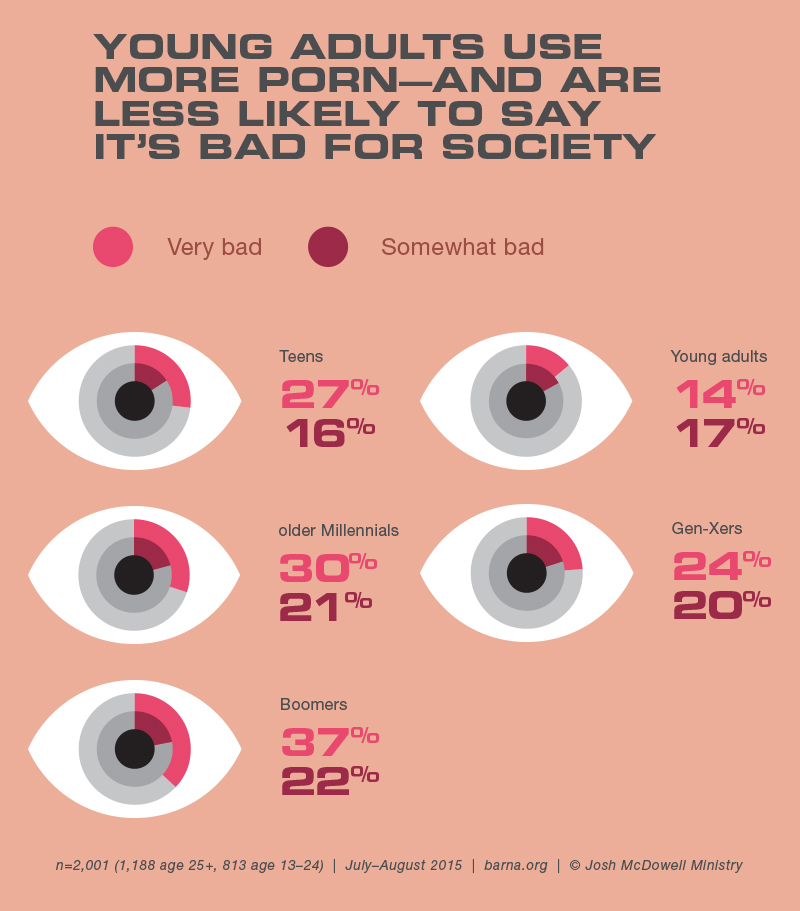
6. Teens and Young Adults Rank not Recycling As More Immoral Than Viewing Porn
When asked to rank a series of action statements (lying, over-eating, stealing, etc) according to a five-point scale: “always OK,” “usually OK,” “neither wrong nor OK,” “usually wrong ” and “always wrong,” teens and young adults rank “not recycling” as more immoral than viewing pornographic images. Combining the percentages of those who chose always and usually wrong for each statement, theft (taking something that belongs to someone else) ranked #1 at almost nine in 10 (88%). Not recycling ranked #4 at 56 percent, and porn was all the way down at #9 with only a third (32%) of teens and young adults ranking it as morally wrong.
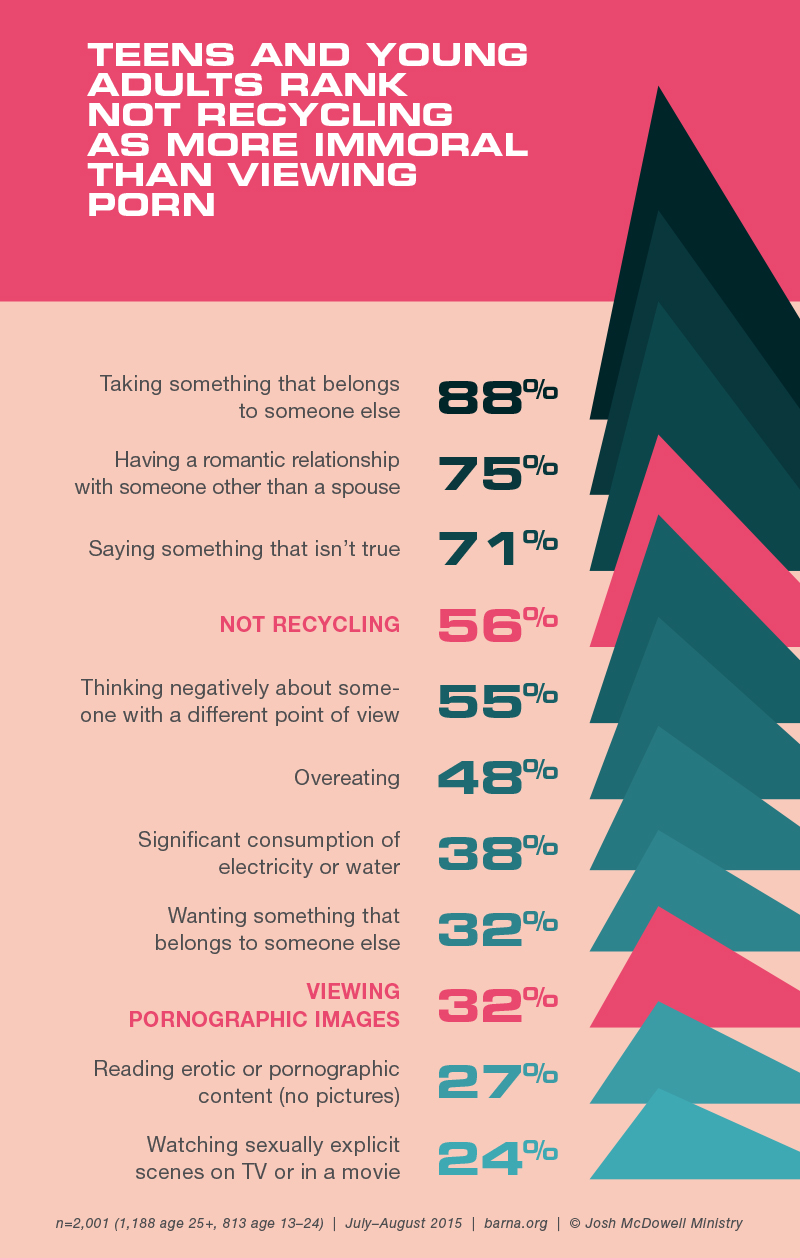
7. Most Porn Users Say it Doesn’t Bother Them to Use Porn
When asked their feelings about porn use, a majority of adults (54%) say it doesn’t really bother them. Interestingly, Gen-Xers and Boomers (both 54%) are the most unbothered by their porn usage. Young adults (51%) and teens (50%) follow closely, with elders appearing the most uncomfortable with their use (47%).
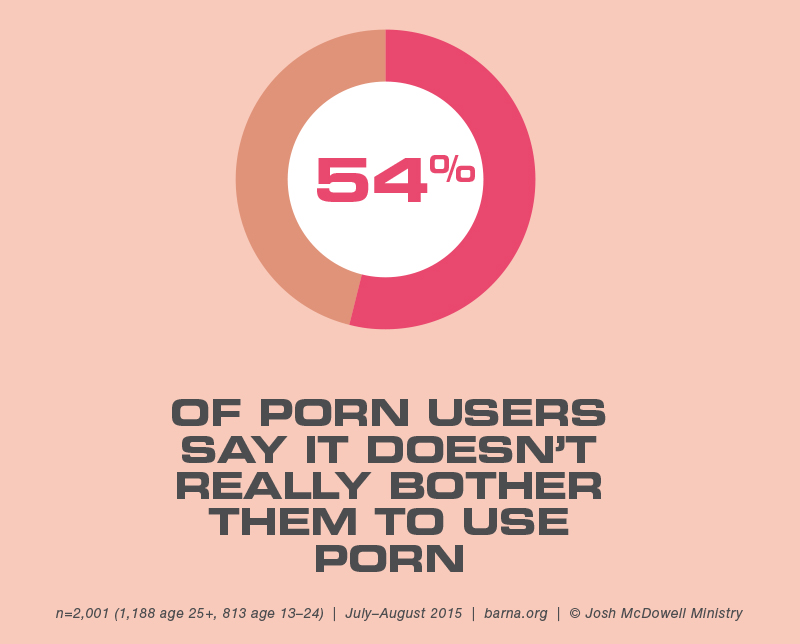
8. Very Few Adults Feel a Sense of Guilt When They Use Porn
Sociopaths aside, human beings tend to feel a sense of guilt when they do something they believe is wrong. When asked about how comfortable they feel about their porn use, only about 1 in five adults overall (18%) report feeling much guilt. Generationally, teens are the most likely age segment to experience feelings of guilt (38%), along with young adults (21%). These are followed by Elders (17%), Boomers (15%), and Gen-Xers (14%). Interestingly, minorities (24% non-white compared to 11% white), practicing Christians (29% compared with 12% of non-practicing Christians), and conservatives (25% compared to 13% of liberals) are significantly more likely to experience a sense of guilt compared to others.
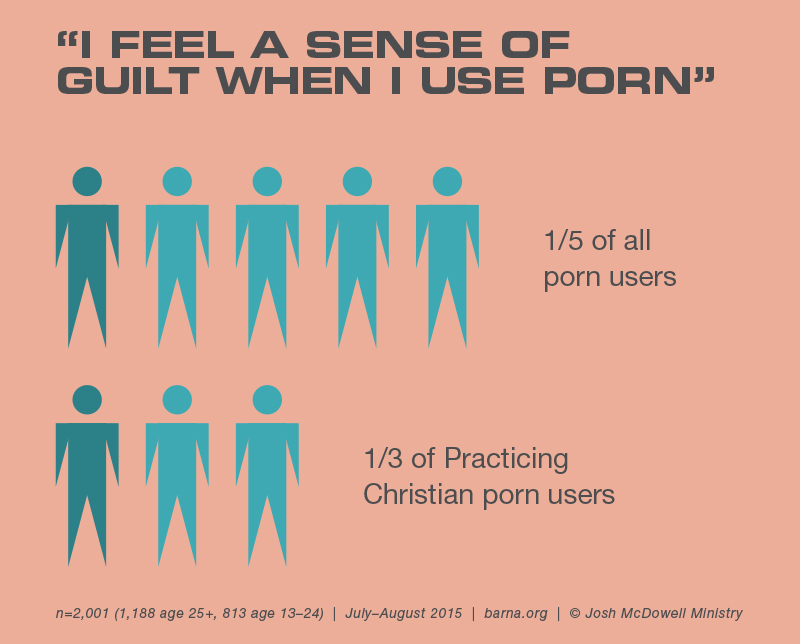
9. Most Porn Users are ok With how Much Porn They Use—But Practicing Christians are Divided
Predictably, practicing Christians who seek out porn at least on occasion are much less comfortable than the general population with their porn use. About two in five say they are comfortable (39%), compared to nearly seven in 10 among all teens and adults (68%). They are also about twice as likely to say they’d like to stop (40%) than to say they’d like to use less (21%). Among the general population of teens and adults, 14 percent say they want to use porn less, and 18 percent would rather not use it at all.
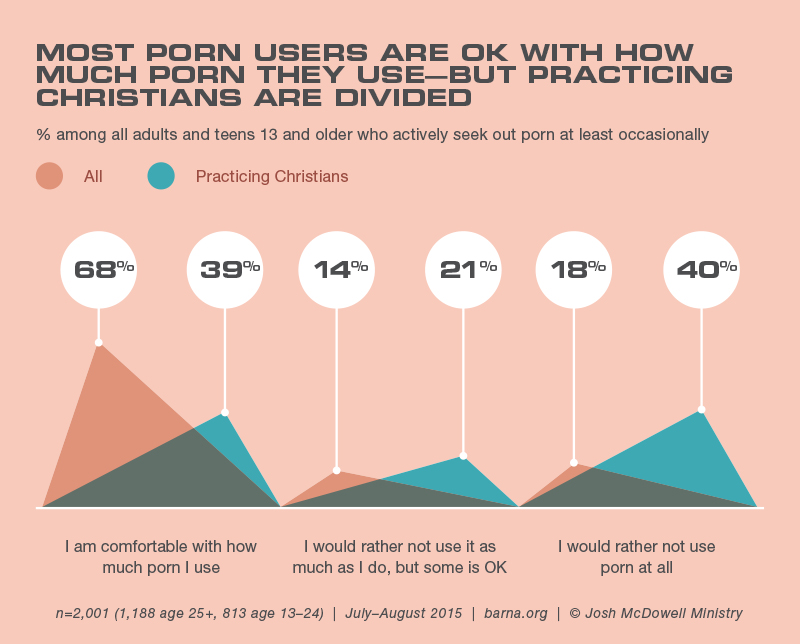
10. Few Adults are Actively Trying to Stop Using Porn
There are a number of effective approaches to combating porn use (accountability groups, counseling, filtering software, etc), but very few adults have either tried to break their habit in the past, or are actively fighting to break their habit now. When the general population are asked whether they have tried to stop using porn, but have been unable to (or started again), only nine percent say so. The rate is almost double among practicing Christians (16%), but still remains fairly low overall. When asked whether they are currently trying to stop using porn, nine percent of the general population agree, while a much larger 19 percent of practicing Christians say they are currently working to kick their habit.
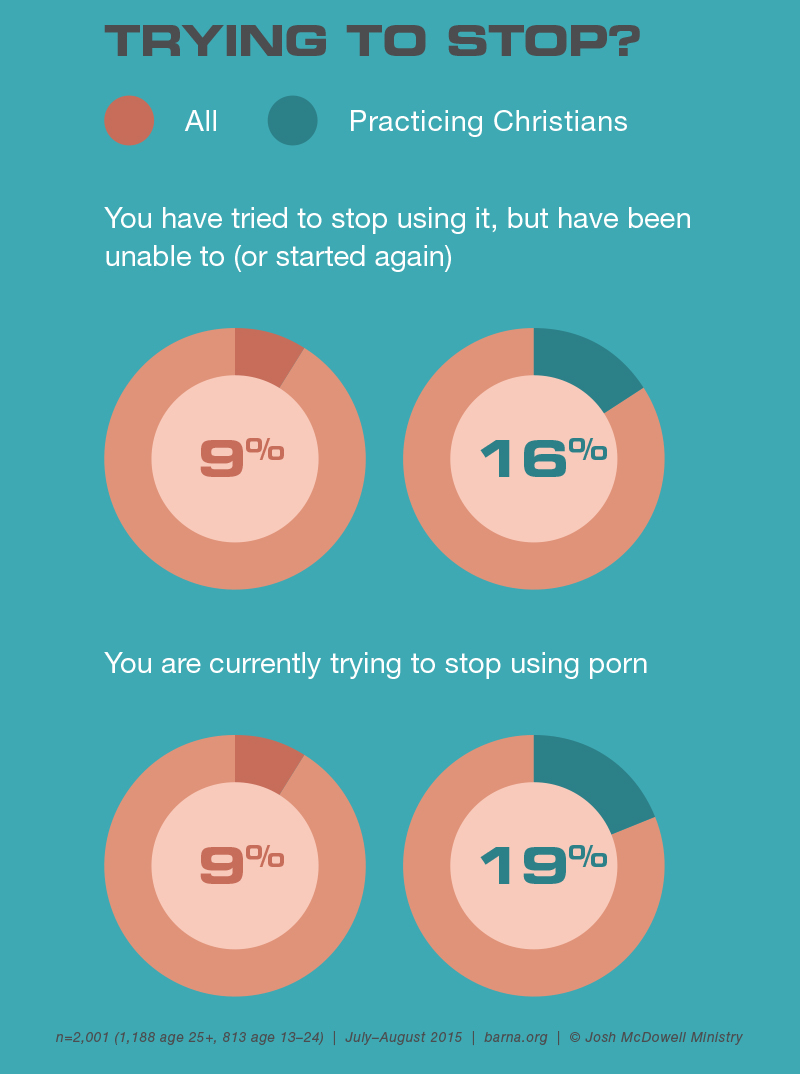
What The Research Means
“One of the primary themes we saw emerging in our research are these generational differences,” says Roxanne Stone, editor in chief at Barna Group and one of the lead analysts on the study. “There are wide gaps between how younger and older generations not only behave toward porn—but also what they believe about porn.
“Much of these changing views and behaviors are likely the result of context,” continues Stone. “Teens and young adults are living in an environment where porn is more acceptable—and more ubiquitous than ever before. As access to pornography has increased, the stigma toward it has seemingly decreased. There is just a general assumption that people are using porn—especially among teens and young adults. And this assumption is not a negative one. When it comes to watching pornography, teens and young adults aren’t getting accountability from their friends—they are getting peer pressure.
“While it may seem crazy that younger generations see not recycling as a greater evil than watching pornography, it’s also true that not recycling—as well as most of the other activities ranked above pornography—has a societal impact,” points out Stone. “Watching pornography, on the other hand, is perceived by many as simply an individual choice. Affecting no one but me. Yet when it comes to assessing porn’s impact on society more broadly, people are more apt to hold a negative view. Which presents an interesting paradox of belief: Porn is fine for individuals but bad for society.
“Today, pornography enjoys a great deal of moral ambiguity,” Stone continues. “But there is hope that the cultural tide will shift and that the dangers and consequences of pornography will re-stigmatize both its consumption and production. For now, porn is everywhere and is likely to stay that way, particularly considering its widespread acceptance and demand. This presents a significant challenge to the Church, and we must respond.
“However, culture-warring ‘moral panic’ has done almost nothing to curb the use of porn or change people’s perceptions of it,” Stone concludes. “We require a new model of social engagement, one marked by joy, grace, and hope. The porn phenomenon is not a time for apocalyptic and hysterical rhetoric, but an opportunity to advance the life-giving messages of the gospel.”
Comment on this research and follow our work:
Twitter: @davidkinnaman | @barnagroup
Facebook: Barna Group
About the Research
The Porn Phenomenon study was produced in partnership with Josh McDowell Ministry.
Barna conducted four online surveys in July and August 2015 for the study, with a total sample of 2,771 par- ticipants. These quantitative studies were preceded by qualita- tive research in the form of an open-ended online survey with 32 adults and 20 pastors on the topics of pornography and sex addiction. This qualitative research served to inform the devel- opment of subsequent survey tools and to provide context for in- terpreting the findings in the final data.
Barna conducted five online surveys in July and August 2015 for The Porn Phenomenon research study, among a total sample of 3,771 participants.
In a survey among U.S. teens and young adults, 813 participants between the ages of 13 and 24 were recruited and surveyed through a national consumer panel. The panel is nationally representative by age, gender, region and socioeconomic grade. The sample error on this survey is plus or minus 3.4 percentage points at the 95-percent confidence level.
In a general U.S. population survey, 1,188 adults 25 years and older were recruited and surveyed separately through a national consumer panel. The panel is nationally representative by age, gender, region and socioeconomic grade. The sample error on this survey is plus or minus 2.8 percentage points at the 95-percent confidence level.
In a survey of U.S. clergy, 338 Christian youth pastors and 432 Christian senior pastors were recruited and surveyed through publically available lists and email invitations. The data was weighted to be nationally representative of churches by denomination, church size and region. The sample error on the youth pastor survey is plus or minus 5.2 percentage points at the 95-percent confidence level. The sample error on the senior pastor survey is plus or minus 4.7 percentage points at the 95-percent confidence level.
In a separate survey on views about sex and women, a total of 1,000 interviews were conducted among U.S. adults 18 years and older. The panel is nationally representative by age, gender, region and socioeconomic grade. Minimal statistical weighting was used to calibrate the sample to known population percentages in relation to demographic variables. The sample error in this survey is plus or minus 3.0 percentage points at the 95-percent confidence level.
© Barna Group, 2016.
About Barna
Since 1984, Barna Group has conducted more than two million interviews over the course of thousands of studies and has become a go-to source for insights about faith, culture, leadership, vocation and generations. Barna is a private, non-partisan, for-profit organization.
Related Posts

What Americans Believe About Sex
- Culture
-
From the Archives

Technology Promises Connection, but Gen Z Sees a Paradox
- Culture
- Generations

New Marriage and Divorce Statistics Released
- Family
-
From the Archives
Lead with Insight
Strengthen your message, train your team and grow your church with cultural insights and practical resources, all in one place.
Get Barna in Your Inbox
Subscribe to Barna’s free newsletters for the latest data and insights to navigate today’s most complex issues.
